l_ode
Rough_Rock
- Joined
- Jun 13, 2022
- Messages
- 30
I just wanted to share my experience with yellow fluorescence!
Seems like all you read about the topic (which is not very much at all) are negative aspects and people tend to be quite scared of yellow fluorescence.
With that said, not everyone might like it, but I still feel that it has a far worse reputations than I think it actually deserves.
There are quite few of them compared to diamonds with blue fluorescence. And seems like people are automatically rejecting the yellow fluorecent ones once they pop up. So maybe that's why it's quite hard to find any information regarding colorless/near colorless diamonds with this attribute. Therefor I really wanted to share my experience and maybe reduce some of that reluctance most people seem to have.
I was very hesitant too at first, mainly because I had no experience of my own in regards of yellow and had only read really negative things about it. Pretty much that you should stay away and that it would make the diamond look more yellow and look like a lower grade on the color scale. Also that it could appear milky (at least if the fluorescence was strong och very strong).
Still, I was curiouse and just bought and received a real beauty which had a medium yellow fluorescence.
I did not get to see the diamond before the purchase since I bought it online och therefor picked it from an online database. But I liked all the other aspects of the diamond based on the GIA certificate and the company assured me they would switch it for me in case I realized I did not like it.
(Short summary: it is a 0.6 carat, 3x, color H, VS2)
So..! In indoors in normal lighting you can't even tell, which seems to be the same for all fluorescent diamonds. It sparkles like crazy, especially under led lights. But no shade of yellow, it looks like the other diamonds.
And in direct sunlight, I can't pick up any yellow there either. I've been staring so much my eyes hurt but no tint, no nothing. It goes quite dark though which I've understood many well cut diamonds do.
And when it come to UV-light and fluorescence... When directing an UV-light at my wedding band, which contains 18 small diamonds, 13 of them instantly lights up in different beautiful blue colors.
But directing the UV-light at my yellow fluorescent diamond barely does anything! It pretty much just remains the same.
In order to pull some yellow out of it I have to go to a completely dark room, close the door and then point the uv-light directly at it. Then I can see a quite lovely yellow nuance. This requires that I hold the uv-light veeery close though.
However i think it is quite pretty and not something bad at all! Although, I kind of love fluorescence in all colors so I might be a bit biased
But I was a bit surprised that is was so hard to actually see the yellow fluorescence! I hade to work really hard and get the precise circumstances. With blue fluorescent diamonds, you can just point an uv-lamp at in anywhere and it will pop!
Conclusion for me is that my fear of yellow fluorescence was unfounded and unfair. I can basically not detect in at all unless I'm in a completely dark room pointing an uv-light directly at in. And even then, the yellow is quite faint. I thought it would be more distinct and would actually have wanted it to glow even more yellow, haha. If the UV-light is not very close the fluorescence almoste looks... white? As if the stone is just glowing with unspecified color.
Well, to me it looks lovely in all light settings but can actually only be detected in the scenario I just described.
Hope someone might find this a bit interesting and that it might lead to someone else not automatically not discarding a beauty based on fear.
I just love my diamond and really thinks the yellow flourescence just adds some personality and charisma to it!
I added a bunch of pictures as well!
Indoors, solitaire is the one with yellow fl
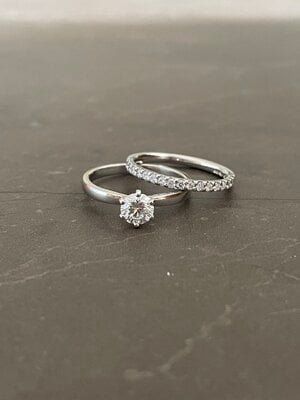
The wedding band which has maaany blue fl diamonds
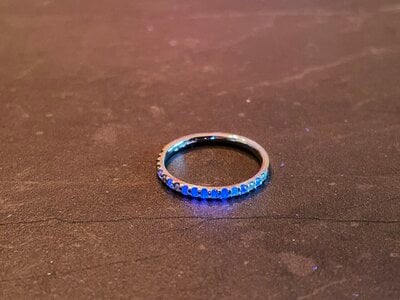
Both of them in indirect sunlight
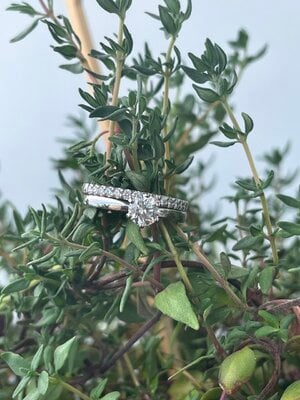
Yellow fl diamond in direct sunlight. It goes quite dark as mentioned.
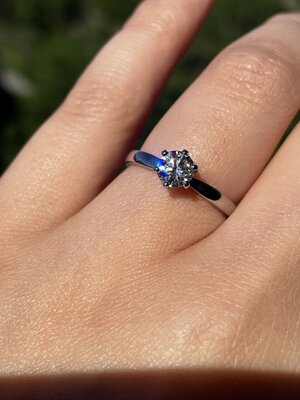
Same diamond in direct sunlight, more from a distance
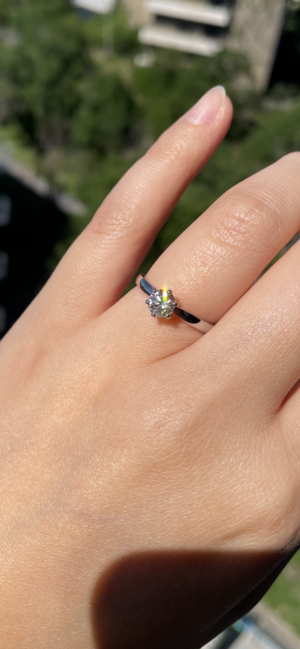
Three pics of yellow fl in totally dark room. Very hard to get sharp pics...
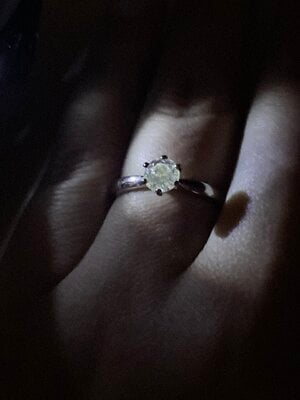
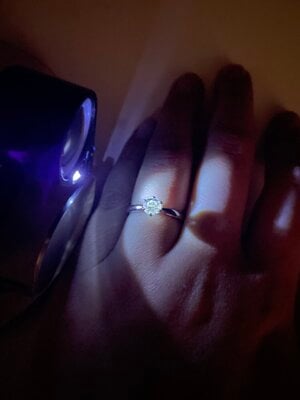
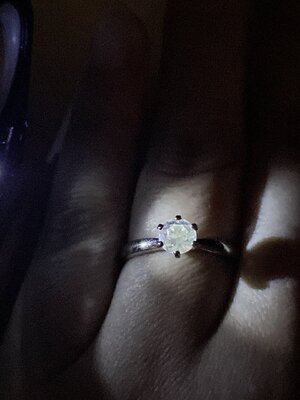
Seems like all you read about the topic (which is not very much at all) are negative aspects and people tend to be quite scared of yellow fluorescence.
With that said, not everyone might like it, but I still feel that it has a far worse reputations than I think it actually deserves.
There are quite few of them compared to diamonds with blue fluorescence. And seems like people are automatically rejecting the yellow fluorecent ones once they pop up. So maybe that's why it's quite hard to find any information regarding colorless/near colorless diamonds with this attribute. Therefor I really wanted to share my experience and maybe reduce some of that reluctance most people seem to have.
I was very hesitant too at first, mainly because I had no experience of my own in regards of yellow and had only read really negative things about it. Pretty much that you should stay away and that it would make the diamond look more yellow and look like a lower grade on the color scale. Also that it could appear milky (at least if the fluorescence was strong och very strong).
Still, I was curiouse and just bought and received a real beauty which had a medium yellow fluorescence.
I did not get to see the diamond before the purchase since I bought it online och therefor picked it from an online database. But I liked all the other aspects of the diamond based on the GIA certificate and the company assured me they would switch it for me in case I realized I did not like it.
(Short summary: it is a 0.6 carat, 3x, color H, VS2)
So..! In indoors in normal lighting you can't even tell, which seems to be the same for all fluorescent diamonds. It sparkles like crazy, especially under led lights. But no shade of yellow, it looks like the other diamonds.
And in direct sunlight, I can't pick up any yellow there either. I've been staring so much my eyes hurt but no tint, no nothing. It goes quite dark though which I've understood many well cut diamonds do.
And when it come to UV-light and fluorescence... When directing an UV-light at my wedding band, which contains 18 small diamonds, 13 of them instantly lights up in different beautiful blue colors.
But directing the UV-light at my yellow fluorescent diamond barely does anything! It pretty much just remains the same.
In order to pull some yellow out of it I have to go to a completely dark room, close the door and then point the uv-light directly at it. Then I can see a quite lovely yellow nuance. This requires that I hold the uv-light veeery close though.
However i think it is quite pretty and not something bad at all! Although, I kind of love fluorescence in all colors so I might be a bit biased
But I was a bit surprised that is was so hard to actually see the yellow fluorescence! I hade to work really hard and get the precise circumstances. With blue fluorescent diamonds, you can just point an uv-lamp at in anywhere and it will pop!
Conclusion for me is that my fear of yellow fluorescence was unfounded and unfair. I can basically not detect in at all unless I'm in a completely dark room pointing an uv-light directly at in. And even then, the yellow is quite faint. I thought it would be more distinct and would actually have wanted it to glow even more yellow, haha. If the UV-light is not very close the fluorescence almoste looks... white? As if the stone is just glowing with unspecified color.
Well, to me it looks lovely in all light settings but can actually only be detected in the scenario I just described.
Hope someone might find this a bit interesting and that it might lead to someone else not automatically not discarding a beauty based on fear.
I just love my diamond and really thinks the yellow flourescence just adds some personality and charisma to it!
I added a bunch of pictures as well!
Indoors, solitaire is the one with yellow fl

The wedding band which has maaany blue fl diamonds

Both of them in indirect sunlight

Yellow fl diamond in direct sunlight. It goes quite dark as mentioned.

Same diamond in direct sunlight, more from a distance

Three pics of yellow fl in totally dark room. Very hard to get sharp pics...




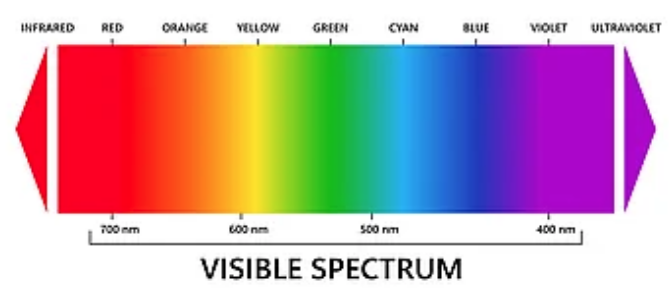
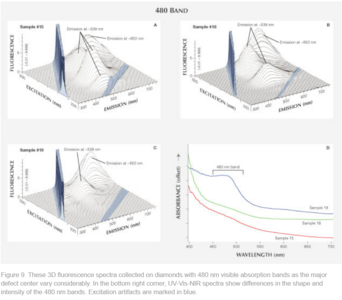



300x240.png)